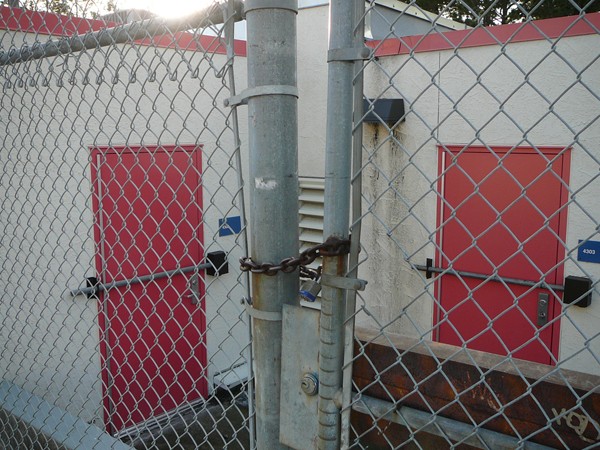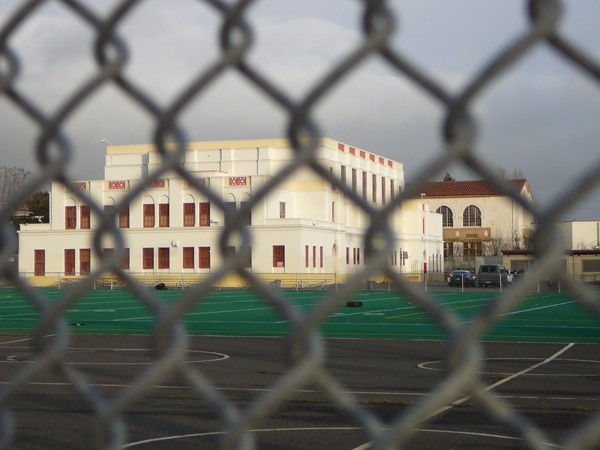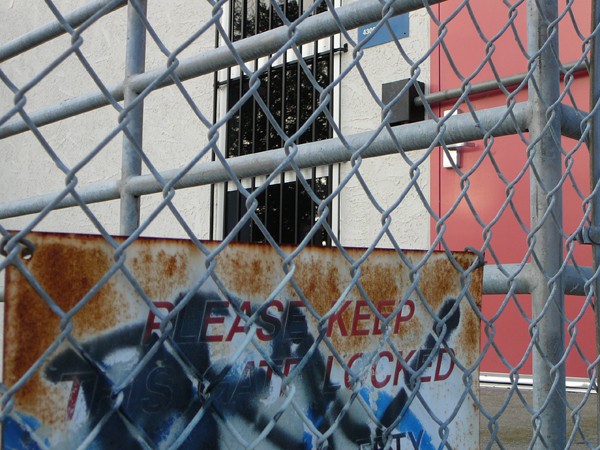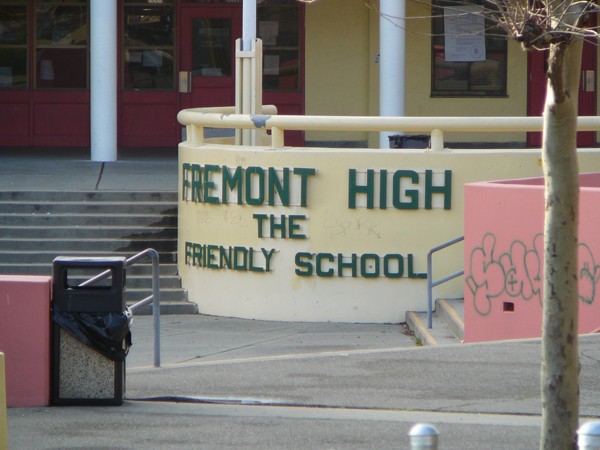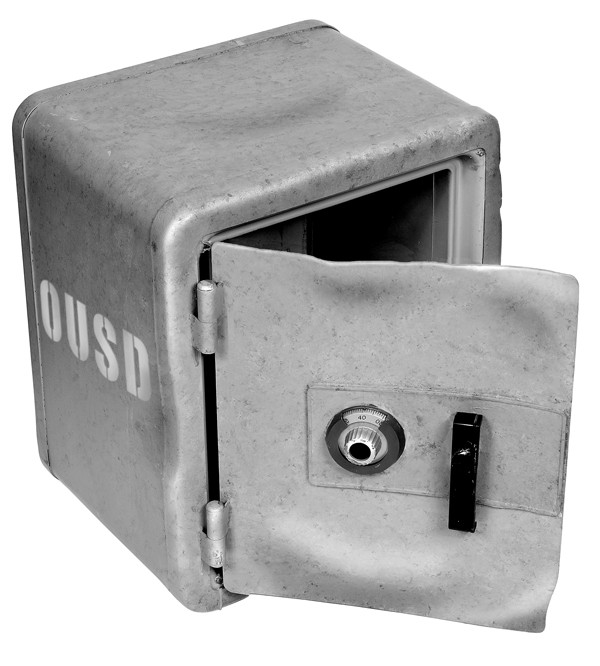At the beginning of Memorial Day Weekend, as barbecue smoke wafted through the air in East Oakland’s Fruitvale neighborhood, a group of thieves snuck onto the campus of the Fremont Federation of High Schools. They had acquired a set of keys and opened the door to the office of Media Academy, one of the four small schools on the campus. Ignoring the roaring alarm set off by motion detectors, they diligently dragged the school’s 300-plus-pound safe out the door, down the steps, and across the schoolyard to the auditorium. Once there, they had at it for three days straight.
It must have been hard work, because at some point, they also broke into the neighboring cafeteria and stole large quantities of snacks to fuel their efforts — even making nachos. The bathrooms were locked, so one of them defecated in the corner of the room. It wasn’t until late Monday night, hours before students would return to class, that they busted the safe door open and collected their prize: laptops, school credit cards, confiscated student cell phones, and several hundred dollars in funds to pay for the upcoming prom.

Locks and fences are commonplace at Fremont Federation of High Schools. Credits: Stephen Buel 
Since Memorial Day, Fremont’s principal estimates that his school has endured almost $40,000 in theft-related losses. Credits: Stephen Buel 
Fences, gates, locks, and window and door bars are everywhere, but can’t stop all the theft. Credits: Stephen Buel 
Credits: Stephen Buel 
Credits: Stephen Buel 
Illustration by Justin Page 
The alarms had blared all weekend, resonating throughout the neighborhood and prompting neighbors to repeatedly call the police. Yet according to Media Academy Principal Benjamin Schmookler, Oakland police didn’t show up until Monday night, after most of the thieves, and all of the loot, had disappeared. The two stragglers they were able to catch, one of whom was a former Fremont Federation student, later got off in a plea bargain.
“The police told us it was a low-priority call,” Schmookler lamented.
Break-ins have been par for the course throughout the principal’s five-year tenure at Fremont Federation. There have been too many to count, he said, with at least a handful each year. “It’s a norm that they’re going to break in and steal,” Schmookler said. “I leave the door to my office open now. ‘Please don’t break the window.'”
The school has repeatedly lost LCD projectors, new computers, flat-screen monitors, and other high-tech equipment purchased for its vocational-media programs. Sometimes it is able to replace the stolen materials, but often it’s not, and students have to make due without. Just since Memorial Day, Schmookler estimates that Fremont has endured at least $13,000 in losses and incurred another $25,000 in expenses re-keying its doors after each incident. By now, he’s all but given up on the police to do much about it.
“It’s obvious the police aren’t coming out here.”
Aside from a custodian who usually sticks around until about 9 p.m. on school days, there are six security guards and two Oakland Police officers stationed at Fremont Federation, but they’re all gone by about 4:30 p.m. and none are around on weekends.
Media High got raided again the first weekend after Christmas break. This time, thieves bent the window grates on a bunch of portable classrooms, sawed open the metal security bar across the door, and made off with ten new iMac computers. They also hit two of the other small schools across campus.
Schmookler said he had a bad feeling about that weekend and called police beforehand to be on the lookout. He wanted them to have keys to the school so they could actually patrol on campus, rather than just doing the routine drive-by. He said the grounds department had given keys to police officers in the past, but that officers repeatedly lost them. So, before the weekend, he personally handed a set to some on-duty officers. Nevertheless, they didn’t show up and the thieves made the rounds with impunity.
Public schools are big targets for thieves in low-income, high-crime neighborhoods where the majority of Oakland schools are situated. They are among the few places in the area with valuable equipment, giving burglars a lot more bang for the buck than robbing a house or store. While some perpetrators have been captured on camera, very few have been caught, and it’s assumed that many of them are former or even current students who have thoroughly staked out the school, come prepared with the necessary equipment, and know exactly what they’re looking for and where to find it.
OPD Sergeant Jack Peterson oversees the nine officers stationed at the city’s six major high schools — none of which are strangers to break-ins. His officers leave campus at 4:30 and his unit often doesn’t even hear about the nighttime break-in incidents, which are handled by whatever patrol is on duty at the time. OPD dispatchers, he explained, give calls to on-duty officers in order of priority, deciding what the officers hear. “We don’t have discretion on what we take or how we take it,” he said. Regarding priority, Peterson added, “it’s life over property,” and an alarm going off, even at a school, is considered low priority compared to the abundance of violent crimes on any given night. “It’s only day or night,” Peterson said, explaining that his unit doesn’t have the numbers to patrol after school hours. “We can’t work both shifts.
“It’s a priority, it’s just that unfortunately we don’t have enough people to go to all calls at once,” he said. “Violent crimes are handled first. Of course it’s a priority, but if you’ve got a bunch of calls involving violence and one call involving a school, what are you going to do?”
It comes down to numbers, Peterson said. There are just not enough officers out there to patrol schools after hours. As has been well-publicized in recent months, the Oakland Police Department is currently short about seventy officers of its authorized 803 total. “I would love to see our department at full force,” Peterson said. “Of course that takes time.”
Yet, there has been some progress, he said, including the installation of cameras on school sites, which he thinks has been a moderate deterrent. Peterson met with Fremont’s four principals the week before the Martin Luther King holiday and conducted a four-day surveillance operation, but didn’t end up catching anyone. He said his unit continues to urge principals and staff to properly secure things of value, noting that in several instances, doors and gates have been left unlocked. Preventing the break-ins is the whole community’s responsibility, he argued. “The responsibility is not on just one agency or person.”
Peterson also thinks it would make a big difference if there were an on-campus nighttime security guard who could directly call police at the moment of the crime. “That changes the complexity of the whole thing,” he said. “A potential burglary on campus makes it a higher priority; it’s a crime in progress.”
Two years ago the Oakland Unified School District reinstated its own school police department, which had been disbanded in 2002, a casualty of budget cuts. Since then, the ranks have been very lean, with a district-wide total of five officers, three of whom are currently injured, according to Arturo Michel, the department’s deputy police chief. Charged with rebuilding the force, he said that five new officers should be arriving in the next few months and hopes to have a total of twelve within a year.
“There has been an inordinate amount of computers taken from different schools,” Michel said, noting that the incidents at Fremont are far from unique. He refers to an incident this year at James Madison Middle School near the San Leandro border, in which eighteen computers were stolen by a group of young teenagers, three of whom were caught.
Although his department doesn’t have incident totals, he said frequent burglaries have occurred in schools throughout the district. While OUSD officials acknowledge the problem, no one seems to have a handle on the actual number of annual incidents and material loss figures. When asked, Michel hesitated to even provide a ballpark figure, referring to the number as “inordinate.”
Incident reports, if even filed at all, go directly to OPD, which then organizes the data by location but does not compile school theft reports in any exclusive format. While the OPD’s online crime statistics reveal the number of incidents within the immediate vicinity of each OUSD school, records only go as far back as ninety days, and no aggregate district figure is available. Chuck Johnston, an OPD crime analyst, says he can find school site totals, but that would involve a formal data request, which takes at least a month.
Michel said schools also are prey to thieves in search of raw materials like glass, copper, and metals that are commonly stripped from buildings and air-conditioning units. He estimates that this school year alone so far, break-ins have cost the district well over half a million dollars.
He’s not surprised by the lack of response from OPD officers, who are often more focused on homicides and other violent crimes. “I think they’re so inundated with calls, and naturally when someone said can you check on an alarm in the school, it’s not a huge priority. They don’t have enough people.”
Without the OPD standing by, Michel said his department has conducted some undercover and night-surveillance operations at different school sites and is in the process of getting monitoring equipment and hiring private security units to patrol campuses. But thus far, these efforts “are just putting a dent in it, not really solving the problem.”
“It’s easy pickings,” he adds. “They really don’t steal, they just kind of go shopping.”
After the January incident, Schmookler marched down to district headquarters and demanded that his school’s damaged facilities be repaired immediately and further secured. The following day, carpenters boarded up the windows of the portables, leaving students in the classrooms with no outside light. Throughout this school year, Schmookler and other campus principals have repeatedly requested a night watchman to patrol the grounds and call police directly during a break-in. They figure the $35,000 in expenses to pay for the guard is far less than the total annual losses and repair costs. Schmookler notes that he has the money to pay for it, but the district has yet to deliver, due in part to a contract dispute with the custodians’ union, who say the job would override their jurisdiction.
Daniel Hurst, the principal of Architecture Academy, another repeatedly robbed school on the Fremont campus, agrees that a night guard is the only way to curb crime. He estimates that his school easily loses at least $50,000 a year in stolen equipment and related facilities damage. It’s so predictable, he said, that he implicitly considers the loss when examining the school’s finances each year, what he refers to as “the cost of doing school in this environment.”
Right before Christmas break and then again on Christmas day, Hurst’s school lost a total of seven computers. He notes the determination of the thieves, who have gone to great lengths in their attempts, including breaking down a wall and crawling under a portable to cut through the floorboards with a chainsaw. When security is tightened in one part of the building, he adds, they’ll just find somewhere else to break into.
“You know what, you’re not going to be able to keep them out,” Hurst said. “If given enough time, they’ll get in. The only thing that can prevent it is a human being [telling the police] there is someone breaking in.” He said police often don’t come because they think it’s a false alarm. But if there was an actual witness who called, he’s confident they’d arrive. “If at that point they failed to show,” he adds, “that would be a huge problem.”
Media High Case Manager Eric DuBois is less forgiving. The son of a former OPD officer, he acknowledges that the force is understaffed and has to prioritize life and death situations over school theft. Yet he finds it hard to understand why no one comes when alarms go off multiple times over the course of a weekend, as was the case on Memorial Day. It’d be pretty unusual, he notes, for a false security alarm to be set off at 2 a.m.
“How can we expect crime to be solved if you have to wait for three different alarms to get police out?” he asks, noting the need for more officers. “There are too many break-ins for them to assume false alarms. That’s not an excuse.”
This has been a rough year at Fremont. Aside from the break-ins, there have been six gun-related incidents on and around campus just since December, including a body found down the street and a teacher who was held up at gunpoint in the early morning at 7:30 a.m. as he walked from car to classroom. In another recent incident, someone came on campus with a gun and the school underwent a lockdown, in which teachers were ordered to lock their doors and not let any students in or out of class. But in some of the portable classrooms, the loudspeaker system was broken and those teachers never heard the announcement.
Among them was Lisa Shafer, who teaches journalism in one of the Media High portables whose windows recently got boarded up. “Break-ins to a school in this neighborhood are especially tragic,” she said. “It’s just heartbreaking.”
Morale among teachers has been affected, she said, partly by the break-ins but just as much by the generally decrepit state of many of the facilities that makes them so easy to break into. Her now-windowless portable was built forty years ago as a temporary structure and is falling apart. She said it takes forever to get anything repaired by the district; the rotting floor got fixed only when she suggested to them that they might have a lawsuit on their hands if someone fell through it.
“I’m disgusted and outraged that students sit in a classroom that’s moldy and has rotting floors and no sunlight,” she said. “It’s pathetic that this is the solution. … What is this saying to students?”
Guillermina Ramirez, a Media High senior, has experienced her fair share of school break-ins, and said it definitely affects her academic ability, especially as senior project deadlines approach with a lack of available computers. But she doesn’t think the break-ins will ever really stop here.
“I think it’s the way it works,” she said. “Around this community we’re used to it.”
Matthew Green is a former journalism teacher at Media High.


